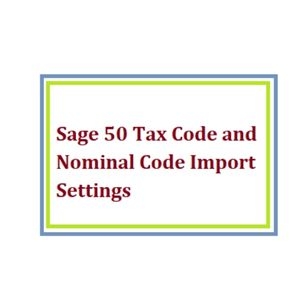Sage 50 Tax Code and Nominal Code Import SettingsPosted by noble david on February 28th, 2023  Tax season is almost upon us, and with it comes the looming worry of whether or not you’ll have to file your taxes. If you’re like most people, you probably don’t want to have to think about it too much. That’s where tax preparation software comes in. But before you run off and buy the most popular tax preparation software out there, there are a few things you should know. In this blog post, we will discuss the differences between the Sage 50 Tax Code and the Nominal Code import settings. This information is important if you plan on using this software to prepare your taxes. Sage 50 Tax Code and Nominal Code Import Settings can be easily adjusted to match your business needs. By using the nominal code import settings, you can customize the tax information for your company. Additionally, you can adjust the tax code to match your business needs. This will help you keep track of your finances and comply with all tax regulations. Find-: Fix sage error code 1603 What is the Sage 50 Tax Code?If you are using a version of the Sage 50 Tax Code or Nominal Code Import tool prior to version 5.3, please see the updated instructions below. If you are using version 5.3 or later, please see the following instructions: To import your company's tax information into Sage 50, first create a file containing your company's tax information in the appropriate format (e.g., Excel spreadsheet). Next, open the Sage 50 Tax Code and Nominal Code Import tool and click on the "File" button. In the "Open File" dialog box, browse to and select your file. The import process will begin automatically and will take about 10 minutes to complete. When it is done, you will be able to view your company's tax information in Sage 50 along with any updates that have been made since the last time this data was imported. The Sage 50 Tax Code is a file used by tax software to import data from an IRS 1040NR or 1040A form. To open the Sage 50 Tax Code, go to: 1. In the Windows Start Menu, search for "Sage 50 Tax Code" 2. When the Sage 50 Tax Code appears in the results, right-click on it and select "Open with..." 3. In the Open with dialog box, select "Microsoft Excel" 4. In Excel, click on the file icon in the upper left corner of your workbook and select "Create a new workbook" 5. On the Workbook tab, scroll down to File Types and click on "File Types" 6. Underneath "Microsoft Excel Workbooks (.xlsx)" you will see a list of file types that are compatible with Excel 7. Click on "Sage 50 Tax Code" and then under Compatibility Mode click on "Excel 2007/2010 (x86)." 8. On the File Type Options dialog box (shown below), make sure that you have selected both the x64 checkbox and Save as type: .xlsx. Once you have selected these two options, click OK to close this dialog box and return to your workbook. Find more-: Fix sage 50 error 3112 9. Click on cell B1 in your workbook and enter 100 in cell A1 of your workbook ( What are Nominal Codes?Nominal codes are a way of categorizing tax rates in a country. They're used to keep track of the different tax rates that apply to different types of income. The Sage Tax Code and Nominal Code Import Settings lets you set up nominal codes for your taxes. If you are using a Sage 50 tax preparation software program, it is important to know how to set up the nominal code and tax code import settings. This will ensure that all of your data is properly imported into the program. The nominal code is a nine-digit number that uniquely identifies each business entity in Canada. The tax code is a two- or three-digit number that identifies the type of income received by a business entity. By setting up the nominal code and tax code import settings, you can ensure that all of your information is properly entered into the Sage 50 software program. How to Import Your Tax File into Sage 50Importing your tax file into Sage 50 is a simple process that can help you keep your fiscal data organized and up-to-date. To begin, open the Tax File menu in Sage 50 and select Import. On the Import Tax File dialog box, enter the filename of your tax file (.csv or .xls) and click OK. Sage 50 will automatically detect which type of file you are importing and will provide options for converting the data between formats. Once the import is complete, you will be able to view your imported data in the Tax Reports panel on the left side of the screen. Note that this import only covers federal taxes; if you have taxes filed in other countries, you will need to repeat this process for each country. ConclusionIf you are preparing your taxes and need help importing the tax code or nominal code, we have the solution for you. Our experts can import the tax codes and nominal codes for you so that you can get ready to file your taxes quickly and easily. Contact us today to learn more about our services! See more-: Set up a bonus account in sage 50 Like it? Share it!More by this author |


